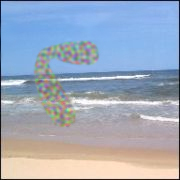Scintillating scotoma

Editor-In-Chief: Prab R Tumpati, MD
Obesity, Sleep & Internal medicine
Founder, WikiMD Wellnesspedia &
W8MD medical weight loss NYC and sleep center NYC
| Scintillating scotoma | |
|---|---|
 | |
| Synonyms | N/A |
| Pronounce | N/A |
| Specialty | N/A |
| Symptoms | Visual aura, zigzag patterns, blind spot |
| Complications | Migraine |
| Onset | Sudden |
| Duration | Typically 20–30 minutes |
| Types | N/A |
| Causes | Cortical spreading depression |
| Risks | Migraine history, stress, hormonal changes |
| Diagnosis | Clinical evaluation |
| Differential diagnosis | Retinal detachment, ocular migraine, transient ischemic attack |
| Prevention | N/A |
| Treatment | Rest, dark room, pain relief for associated migraine |
| Medication | N/A |
| Prognosis | N/A |
| Frequency | Common in individuals with migraines |
| Deaths | N/A |






Scintillating scotoma is a visual phenomenon that is often associated with migraine headaches but can occur independently. It is characterized by a temporary, partial field of vision disturbance that usually affects both eyes. Individuals experiencing a scintillating scotoma may see flickering or shimmering lights, blind spots, or geometric patterns, often with a zigzag border that can expand and move across the field of vision. This phenomenon typically precedes the headache phase of a migraine in what is known as the aura phase, although it can also occur without any subsequent headache.
Causes and Mechanisms[edit]
The exact cause of scintillating scotoma is not fully understood, but it is believed to be related to a wave of electrical activity that sweeps across the brain, specifically the cerebral cortex, which is responsible for processing visual signals. This phenomenon is known as Cortical spreading depression. It temporarily alters neural activity and blood flow in the brain, leading to the visual disturbances characteristic of scintillating scotoma.
Symptoms[edit]
Symptoms of scintillating scotoma include:
- Visual disturbances that appear as flickering or shimmering lights
- Zigzag patterns that may expand and move across the field of vision
- A blind spot or partial loss of vision that typically lasts less than an hour
- Headache, which may follow the visual symptoms, although not always
Diagnosis[edit]
Diagnosis of scintillating scotoma primarily involves a detailed medical history and a physical examination. Healthcare providers may also perform a comprehensive eye examination to rule out other potential causes of visual disturbances. In some cases, further testing, such as MRI scans, may be conducted to exclude neurological conditions.
Treatment[edit]
There is no specific treatment for scintillating scotoma. Management strategies focus on treating the underlying migraine condition, if present, and may include medications to relieve migraine symptoms or prevent migraine attacks. For individuals who experience scintillating scotoma without subsequent migraines, lifestyle modifications and avoiding known migraine triggers may be recommended to reduce the frequency of episodes.
Prevention[edit]
Preventive measures for scintillating scotoma involve identifying and avoiding personal migraine triggers, which may include stress, certain foods, or changes in weather. Regular exercise, adequate sleep, and maintaining a healthy diet can also help reduce the frequency of migraine attacks and associated visual disturbances.
Ad. Transform your life with W8MD's Budget GLP-1 injections from $75


W8MD offers a medical weight loss program to lose weight in Philadelphia. Our physician-supervised medical weight loss provides:
- Weight loss injections in NYC (generic and brand names):
- Zepbound / Mounjaro, Wegovy / Ozempic, Saxenda
- Most insurances accepted or discounted self-pay rates. We will obtain insurance prior authorizations if needed.
- Generic GLP1 weight loss injections from $75 for the starting dose.
- Also offer prescription weight loss medications including Phentermine, Qsymia, Diethylpropion, Contrave etc.
NYC weight loss doctor appointmentsNYC weight loss doctor appointments
Start your NYC weight loss journey today at our NYC medical weight loss and Philadelphia medical weight loss clinics.
- Call 718-946-5500 to lose weight in NYC or for medical weight loss in Philadelphia 215-676-2334.
- Tags:NYC medical weight loss, Philadelphia lose weight Zepbound NYC, Budget GLP1 weight loss injections, Wegovy Philadelphia, Wegovy NYC, Philadelphia medical weight loss, Brookly weight loss and Wegovy NYC
|
WikiMD's Wellness Encyclopedia |
| Let Food Be Thy Medicine Medicine Thy Food - Hippocrates |
Medical Disclaimer: WikiMD is not a substitute for professional medical advice. The information on WikiMD is provided as an information resource only, may be incorrect, outdated or misleading, and is not to be used or relied on for any diagnostic or treatment purposes. Please consult your health care provider before making any healthcare decisions or for guidance about a specific medical condition. WikiMD expressly disclaims responsibility, and shall have no liability, for any damages, loss, injury, or liability whatsoever suffered as a result of your reliance on the information contained in this site. By visiting this site you agree to the foregoing terms and conditions, which may from time to time be changed or supplemented by WikiMD. If you do not agree to the foregoing terms and conditions, you should not enter or use this site. See full disclaimer.
Credits:Most images are courtesy of Wikimedia commons, and templates, categories Wikipedia, licensed under CC BY SA or similar.
Translate this page: - East Asian
中文,
日本,
한국어,
South Asian
हिन्दी,
தமிழ்,
తెలుగు,
Urdu,
ಕನ್ನಡ,
Southeast Asian
Indonesian,
Vietnamese,
Thai,
မြန်မာဘာသာ,
বাংলা
European
español,
Deutsch,
français,
Greek,
português do Brasil,
polski,
română,
русский,
Nederlands,
norsk,
svenska,
suomi,
Italian
Middle Eastern & African
عربى,
Turkish,
Persian,
Hebrew,
Afrikaans,
isiZulu,
Kiswahili,
Other
Bulgarian,
Hungarian,
Czech,
Swedish,
മലയാളം,
मराठी,
ਪੰਜਾਬੀ,
ગુજરાતી,
Portuguese,
Ukrainian
